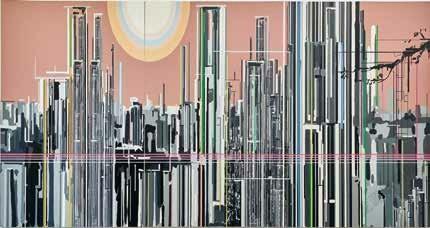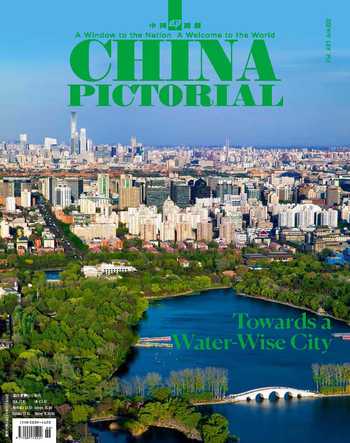Common Ground:UCCA 15th Anniversary Patrons Collection Exhibition
by Nancy Gong
In celebration of its 15th anniversary, UCCA Center for Contemporary Art planned a large-scale group show titled “Common Ground: UCCA 15th Anniversary Patrons Collection Exhibition,” which is on view at UCCA Beijing from April 16 to July 3, 2022. Curated by members of the UCCA curatorial team from the extensive collections of members of the UCCA Foundation Council, the exhibition showcases nearly 100 works by 51 Chinese and international artists and groups that reflect recent trends in contemporary art.
UCCA has grown into one of the most recognized independent art institutions in China since its opening in 2007. In 2012, the UCCA Patrons Council was founded, the first program of its kind among art museums in China. Ten years on, the program has matured into a community of like-minded global supporters who together enable UCCA to present a diverse and substantive exhibition program to ever larger audiences. In turn, UCCA has furnished its patrons, many of whom are art collectors, with a platform for dialogue and study.

“We are delighted to begin a season of anniversary celebrations by looking at connections between UCCAs most devoted group of supporters and the contemporary art scene we are all together committed to creating,”said UCCA Director and CEO Philip Tinari. “In addition to showing great art, UCCA has always been committed to forging new models of institutional practice. Now as ever, the special interplay between artists and UCCAs patrons, teams, and visitors creates‘Common Ground on which we can all come together.”
By placing works collected by members of the UCCA Foundation Council (the highest tier of UCCAs individual giving program) within current narratives of contemporary art, the curatorial team, led by Guo Xi, structured the exhibition into five sections: “The Fluid Landscape,”“Epiphany of the Individual,” “Whose Tradition,” “Images and Forgetting,”and “Rethinking the Conceptual.” The exhibition seeks to position these works within the historical contexts of their making and the current narratives of contemporary art, while opening up new lines of inquiry.

The opening section, “The Fluid Landscape,” curated by Ara Qiu, looks at landscapes as a dynamic medium. The landscape has long been portrayed in art as an object endowed with aesthetic significance and continues to evolve in meaning to this day. From the reconstruction of natural landscapes on a universal or atmospheric scale—as in the works by artist such as Cui Jie, Jake Longstreth, Liu Xiaodong, Liu Wei, Zhang Enli, and Zhao Yao—to birds-eye views of man-made megastructures and the depiction of inner landscapes shaped by the symbolic projection of emotions, the works in this section explore how the significance of landscapes is constantly shifting as they become enmeshed with our cultural and social constructs. These works may drive viewers to ask: Could curiosity and self-reflection lead us to a beautiful and secluded clearing of our own?54574712-9378-48FC-B1DA-12B8C922684B


Turning towards the interior,“Epiphany of the Individual,” curated by Fang Yan, focuses on affection and spirituality within art, featuring works by artists representing different countries and eras including Qiu Xiaofei, Jia Aili, William Kentridge, Ma Qiusha, and Yu Hong. These pieces take off from the artists respective historical backgrounds, cultural contexts, and individual experiences, conveying concerns and aspirations for the fate of humankind. Together, these various works pose the question: Can art again accept its ancient role of helping people trace, reread, and transcend the progression of history embedded in complex temporalities through concrete experiences and emotions?
The next section, “Whose Tradition,”curated by Neil Zhang, features works by artists caught in the gap between globalization and cultural specificity. As the development of contemporary art paralleled the rise of globalization and postcolonialism, artists in this section such as Hu Xiaoyuan, Liang Yuanwei, Ji Dachun, Hiroshi Sugimoto, Akira Yamaguchi, Shi Xinji, and Sun Xun reflect on the ostensibly binary opposition between the classical and the contemporary through the form and content of their works, while interrogating whose tradition is ultimately at stake in the struggle and pursuit of cultural identity.
Likewise in a critical look at the present, “Images and Forgetting,”curated by Bian Ka, assembles works by artists including Beeple, Li Songsong, Shi Chong, Yang Fudong, Zhang Ding, and Zhang Xiaogang. Under markedly divergent circumstances from the past, today, images are shaped by the trends of globalization and financialization and authenticated by encryption. This section centers on the primacy of images to examine the concepts of “new” and“old” in images, as well as the meaning of images as they become complicated by human memories and knowledge. What new meanings have been imputed to artists and images along with the development of our times and changes in our knowledge of the world?
Finally, “Rethinking the Conceptual,”curated by Luan Shixuan, returns to discussion of the concept of art itself. Since the first wave of conceptual art in America in the late 1960s, contemporary art has undergone a shift in form, style, and media. Through the works of artists such as Dahn Vo, Barbara Kruger, Song Dong, Shu Qun, Wu Shuzhuan, and Wang Guangyi, this section studies the rich lineage of conceptual art across eras, regions, and cultures to explore the subtle tensions within this field, surveying the various creative strategies and development of conceptual art.54574712-9378-48FC-B1DA-12B8C922684B

